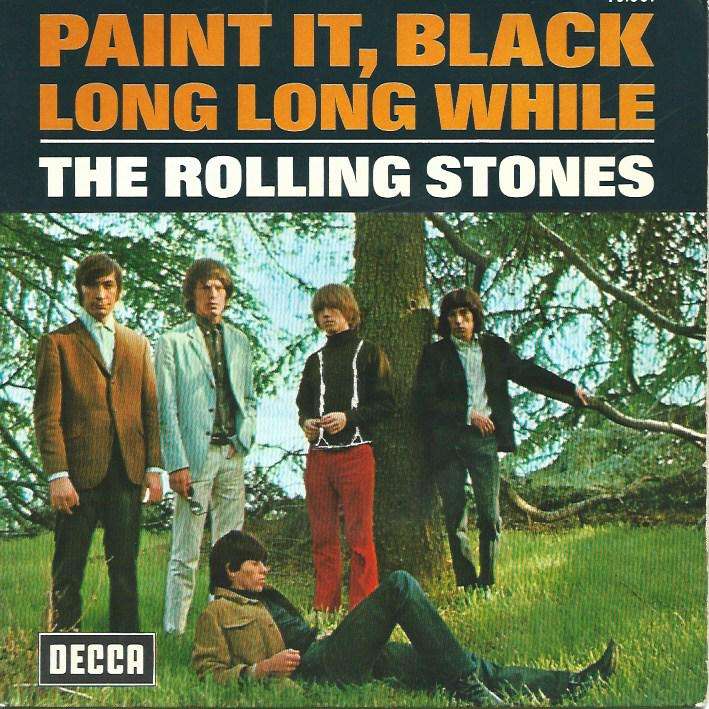June 11, 1966
- STAYED AT #1:2 Weeks
In The Number Ones, I'm reviewing every single #1 single in the history of the Billboard Hot 100, starting with the chart's beginning, in 1958, and working my way up into the present.
Mick Jagger is singing about a dead lover. He never quite makes it explicit that that's what he's doing it, but it's all there in the lyrics, indicated in images and memory-shards. "I see a line of cars, and they're all painted black," he sings with a detached sort of wonder, like he's not quite processing what's happening in front of his face. "With flowers and my love, both never to turn back." And then he gets dark.
The rub is that Jagger isn't really singing about that dead lover. He's singing about himself -- about the new chasms of emptiness that are opening up inside of him. He looks around at the world, and he toggles back and forth between incomprehension and total disgust. He can't even lose himself in the comfort of sex, which is always Jagger's default option: "I see the girls walk by dressed in their summer clothes /I have to turn my head until my darkness goes." Vocally, he goes from blank, numb flatness to frothing rage, fading and exploding and then fading and exploding again. The dead lover is a pure abstraction. The immediate concern is the depression that's crushing and overwhelming Jagger.
"Paint It Black" remains one of the heaviest, darkest songs ever to top the Billboard Hot 100. Like the Animals' "The House Of The Rising Sun" before it, it's a proto-goth cinematic odyssey into bad feelings. But this time, the bad feelings are a lot plainer and more apparent, even if Mick Jagger is only singing of them allusively, drawing on Ulysses and fractured imagery. It's a song that conjures a bleak, dark, obsessive feeling -- a song about being trapped in depression that finds ways to translate that inner turmoil into something resembling pop music.
It takes a crazy level of ambition to attempt to channel a feeling like this while making a single, but the Rolling Stones did it, and they made it work. They had to overhaul their whole musical approach to do it. "Paint It Black" has all the fuzzed-out savagery of "(I Can't Get No) Satisfaction" and "Get Off Of My Cloud," the Stones' previous two chart-toppers. But it has none of that primal, elemental blues-rock swagger. Instead, the Stones left their beloved American bluesmen alone and drew from other sources.
Brian Jones was getting bored with rock 'n' roll by the time the Stones made "Paint It Black." He was looking elsewhere for inspiration, studying sitar under the Indian master Harihar Rao, a Ravi Shankar protegé. George Harrison was studying sitar at the same time, and he included the instrument, and the idea of Eastern minor-key music, on the Beatles' "Norwegian Wood" before the Stones made "Paint It Black." Jones scoffed at the idea that he was imitating the Beatles, but it's hard not to see this as one of the best outcomes of the mythic Beatles/Stones rivalry -- one band helping push the other toward coming up with one of their best songs.
But the sitar isn't the only thing that "Paint It Black" has going for it. There's Keith Richards' eerie, spidery guitar -- that's him on the intro, not Jones. There's the way that guitar turns into slashing urgency when Jagger ramps up the intensity. There's Charlie Watts, his drums turning into a grim militaristic death-march on that fiery, spacey bridge, or the weird wobbly bass noises that Bill Wyman brings in. Every last member of the band gets weird on "Paint It Black," and yet they all remain in lockstep with one another, universally committed to cranking out swirling doom-blues.
From there, the Stones would push further into the psychedelic ether on the 1967 album Their Satanic Magesties Request before snapping back to the blues-rock blueprint in the years that followed. As a result, there aren't really any other songs like "Paint It Black," from the Rolling Stones or from anyone else. It's a perfect historical storm, a glorious little nightmare.
GRADE: 10/10
BONUS BEATS: I could use this space to post any number of "Paint It Black" covers -- Eric Burdon and War, U2, Ciara, W.A.S.P., Ministry, the Feelies, Fennesz, Earth Crisis. But instead, here's Big Star referencing "Paint It Black" on their own 1972 masterpiece "Thirteen":






